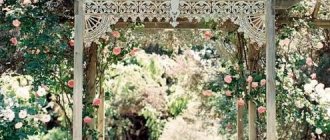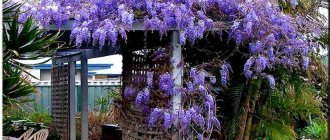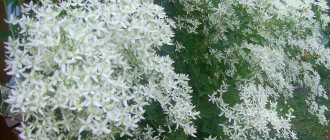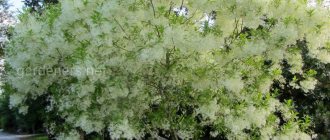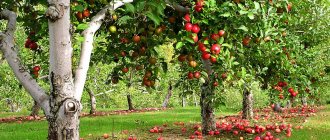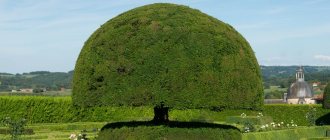There is nothing more pastoral and spectacular than a gazebo or pergola covered with a luxurious canopy of climbing plants. It beckons you to enjoy relaxation, communication, taste tea or dine in the fresh air. Despite the fact that in themselves these representatives of small garden architecture make an impression, they become cozy and inviting only with proper landscaping, which not only connects the elegant structure with the rest of the garden, but also creates a special atmosphere. The choice of vines that can be used for arbors and pergolas is very large - from classic flowering and deciduous plants to extravagant and temporary plants.
Climbing roses on the gazebo
Landscaping a gazebo and pergola is a fascinating process, allowing you to reveal your tastes and create the relaxation space you have always dreamed of. Starting from modest hanging ampels to flower beds and potted gardens all around, there is room for your imagination to run wild. But still, potted plants, container plants, and ornamental plants planted in the soil are just auxiliary means. The main tool for landscaping pergolas and gazebos, regardless of the style of the garden and its size, has always been and remains magnificent vines.
Talented steeplejacks, effectively draping objects of small architecture and soaring upward, like a luxurious living fabric, soften the lines, hide bulkiness, and transform the atmosphere. A single liana can tie together a gazebo and the surrounding landscapes, creating a feeling of peace, naturalness and that very harmony that we all strive for in our own gardens. Even a very beautiful structure without a vine seems like an alien object, and it is imperative to “fit” it into the garden. Of course, vines also play a purely practical role - they enhance shading, give coolness, make relaxation secluded, hide from wind, rain, prying eyes and vanity, and give a feeling of complete security.
Choosing a vine to decorate a gazebo or pergola is not an easy task. If almost any vine will look impressive on an arch, support, pyramid or fence, then on a pergola and gazebo it should also look flawless. And it’s worth taking into account all the nuances:
- terms of plant decorativeness;
- deciduousness or the ability to retain leaves for the winter;
- attractiveness in early spring and late autumn;
- timing and palette of flowering;
- leaf canopy density;
- tendency to “litter”—to scatter dry petals, leaves, sticky sap, or pollen—or to remain relatively clean;
- saturation of leaf color and crown texture;
- compliance with the style of the garden and techniques already used in vertical gardening;
- the need for shelter for the winter and removal from support, as well as your ability to provide shelter (for landscaping gazebos and pergolas, it is better to choose plants adapted to your climate rather than exotic crops);
- plant longevity;
- growth rate and maximum size;
- compliance of the dimensions of an adult vine with stability, strength and dimensions of the pergola or gazebo structure.
You shouldn’t ignore even one of these points. Agree, there is little pleasure in a gazebo completely covered with sticky hop pollen, which is both difficult and unpleasant to clean. And its loose, often sloppy and “leaky” crown does not always live up to expectations from a beautiful deciduous canopy, becoming hopelessly exposed already at the beginning of autumn. A small gazebo with carved details will also become a problem for a huge wisteria, which with age will threaten the entire structure. Just as it would not be appropriate for an elegant miniature pergola with thin supports. And lemongrass is beautiful only in summer - neither in spring nor in autumn it will please your eyes.
When choosing a vine for landscaping these small architectural objects that are important not only from an aesthetic, but also from a functional point of view, you must not forget that the chosen plant will be a kind of partner or companion to your gazebo or pergola for decades. And you simply must predict its growth and take into account all the shortcomings.
Clematis on the pergola
For landscaping the gazebo, only 1-2 vines are used, and if you want to achieve a complex image, then you need to select literally ideal partners and time-tested duets (for example, a combination of roses and clematis). But it’s still better to choose one vine that will be easier to control and allow it to reveal all its beauty.
Let's take a closer look at the favorites for landscaping gazebos and pergolas.
Blooming stars for pergolas and gazebos
Climbing roses remain the absolute favorites for decorating gazebos today. They create a fabulous effect, reminiscent of illustrations of magical stories. Magnificent and regal roses with their glossy foliage and luxurious inflorescences with semi-double, double, fragrant or not so fragrant flowers even on a gazebo seem like a blooming cloud. Caring for a climbing rose is not so easy - it needs pruning, watering, fertilizing, special preparation for winter, but the annual growth of several meters and the greatness of flowering allow you not even to notice such “little things”. But the classics always have an alternative, and not necessarily less spectacular in terms of lush color and catchiness.
Clematis is the best partner and the most popular climbing vine for landscaping pergolas and gazebos. Large saucer flowers, even in the most modest species of clematis, still give the impression of being unusual and eye-catching. It is the flowering of clematis that seems to tie together a gazebo or pergola with a plant and a garden, creating a kind of connecting link. And flexible shoots and visual weightlessness organically complement the appearance of the structures.
Hardy and trouble-free species clematis or the most diverse in terms of winter hardiness, size, structure, flower color and hardiness, varietal clematis allow you to choose a plant in accordance with your lifestyle and individual preferences. Red and lilac, lilac and violet, blue, cream, white and even chocolate - the color of clematis flowers can be both original and classic. Clematis are quite capricious crops.
Arbors and pergolas provide them with two important conditions necessary for their successful growth - constant air circulation in the crown and protection of the root system from overheating. Clematis need watering, regular fertilizing, loosening the soil, shelter for the winter and pruning depending on the timing of flowering. But their bright, large leaves and the beauty of their blooms make all the effort worthwhile.
Honeysuckle (Lonicera) is also a great landscaping option. True, these plants look better not on gazebos, but on pergolas (but they can also be used as a universal landscaping plant). Numerous types of honeysuckle allow you to choose between vines with a height of 5 m and more compact types. Classic choice for pergola and gazebo:
- honeysuckle (Lonicera caprifolium) with attractive leaves and pink flowers;
- climbing honeysuckle (Lonicera periclymenum) with its classic beauty of dark leaves in a dense crown and delicate numerous flowers;
- Brown's honeysuckle (Lonicera brownii) with clusters of red-orange tubular flowers reminiscent of fuchsia, etc.
The main advantage of all honeysuckles is that they do not require special care, are hardy, bloom profusely and unusually, delight the eye with fruits (even if not always edible), and delight the nose with an evening aroma.
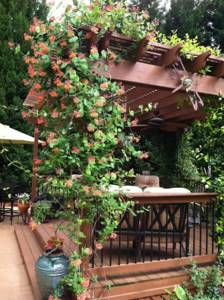
Honeysuckle on a gazebo post
Campsis is a relative newcomer and a representative of the original modern vines, which have gained well-deserved popularity only recently. It is not afraid of even heavily polluted air, it is hardy, unpretentious, effective, and the only drawback of this vine is actually the need to cover it for the winter. The complex pinnate leaves of an unusual shade of dark green create a spectacular patterned lace, against the background of which numerous tubular bells of flowers of red, orange, and yellow colors appear to be flames. Campsis looks best on a pergola.
One of the most original plants in terms of flowering type is Kirkazon , or Aristolochia .
This climbing vine with dense and dense, large, heart-shaped, cold green foliage with an emerald tint captivates with its original flowers. Aristolochia looks great on both pergolas and gazebos, being one of the best “alternative” vines for decorating a garden in a modern style.
Type of material for garden arch
There are several variations in base material. For example, plastic is more suitable for openwork decorative structures that complement the garden design in the autumn, when fallen leaves expose the stem. Wood or metal can withstand significant loads and form the shape of the bush that the owner intended. Their equally elegant design makes it possible to fit the structure into any garden design, regardless of its size.
Brick and stone for arches are used in large areas. The aesthetics of such a structure are great enough that it does not require landscaping. The complexity of installation and the high cost of the material make them of little demand for personal plots.
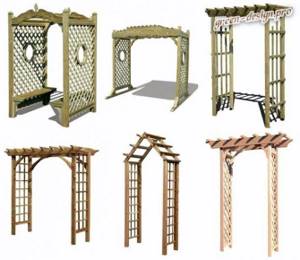
Types of arches and pergolas
A garden arch for climbing plants can be built with your own hands from almost any material. Most often they resort to this for the construction of low structures made of pipes or simple wooden buildings. But truly original and multifunctional structures are thought out by architects and designers.
The most popular is a metal garden arch for climbing plants. You can buy this design at a fairly reasonable cost. And the variety of designs is truly amazing. Some variations involve the use of elements made of wood and even stone, with intricate patterns or clear lines. Forged petals that are attached to the base of a metal arch are also popular.
The best decorative deciduous vines for gazebos and pergolas
The most versatile climbing assistant (and universal in aesthetics, stylistic expressiveness, and ease of cultivation) is ivy (Hedera). This plant needs no introduction. Flexible shoots that can take root in the soil are ready to rise to any height, creating a dense and light canopy of luxurious glossy leaves. The ivy cover looks both classic and elegant at the same time. The pattern, the amazing attractiveness of the leaves, the ability to choose variegated varieties, the change of autumn color with a slight purple and copper touch, the preservation of greenery for the winter and hardiness make ivy an indispensable plant in the decor of gazebos and pergolas.
Moreover, in regions with harsh winters there are no evergreen alternatives to ivy. It is appropriate in a strict regular style, and in modern design, and in a rural garden. Shade-tolerant and moisture-loving ivy is easy to control and even easier to shape, allowing you to achieve surprisingly expressive effects. And the freshness and coolness in the gazebo covered with ivy will pleasantly please you at the height of summer.
The spectacular maiden grape (Parthenocissus) is the main competitor of ivy, but this is a plant with much larger dimensions and scope. It is no coincidence that the maiden grape is so popular in urban landscaping: it can indeed “grow” up to 20 m in length. And although it is often called an aggressor, in fact it is easy to direct and control. Fast growth, endurance, durability, almost complete lack of care - these are the main advantages of this plant.
Luxurious glossy foliage, consisting of three or five pointed lobes, forms an ornamental crown, gives coolness and creates a surprisingly dense canopy. And in the fall, muted green gives way to dazzling purple and crimson tones. This is one of the best vines for shading and keeping a gazebo cool even in the middle of summer.
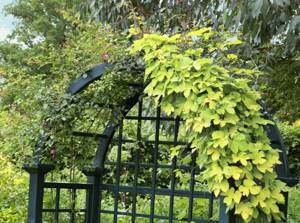
Maiden grapes and climbing rose on the arch
For landscaping large massive arbors or pergolas, you can use a plant with a very controversial reputation - wood pliers , or round-leaved red bladder (Cellastrus aculeatus), the very name of which is alarming. But the wood plier is dangerous only for the arboreal ones, which it really can strangle with its embrace. But twisting it counterclockwise and hook-shaped formations for clinging to the surface will not harm the gazebo or pergola. The beauty of tree pliers cannot but captivate, and if there is no danger that the vine will spread to a neighboring tree and you will control its shoots, feel free to consider the option of using this aggressor as an ornamental plant.
The thick and seemingly curly crown of the plant with round, dense, glossy-bright leaves up to 10 cm in length forms a surprisingly elegant canopy. The rich green color changes to gold-orange and catchy in the fall. But greenish flowers at the beginning of summer, on the contrary, are almost invisible. In autumn, brightly colored fiery fruits shine against the background of yellowing foliage, decorating the garden, and in winter, bright red seeds with long stalks, emerging from seed pods, add expression to the snow cover.
This vine is capable of climbing to a height of up to 8 m, and there is also a dwarf form with shoots up to only 5 m long and with smaller leaves. Tree pliers do not need shelter for the winter (only the soil is mulched for the first winter), are easily controlled by February pruning and thinning of the crown, and require only a few waterings per season and a single early feeding.
Highlanders are very unusual vines both in the texture of their greenery and in their character. Despite freezing above the snow line, by summer they usually completely cover the pergola or gazebo and allow you to admire the luxurious crown pattern. These plants “suffered” a lot from the inconsistency of scientists, who changed their classification so often that they completely confused all gardeners. An absolute favorite for the middle zone, Aubert's knotweed , is today classified as a member of the genus Fallopia and its “correct” botanical name is Fallopia aubertii, although for many years it was classified as Polygonum aubertii.
Its ovoid leaves up to 9 cm long with a wavy edge change the “young” reddish color to bright green, create a feeling of ornamentation and emphasize the beauty of the long lashes of shoots, which in the middle of summer cover whitish flowers collected in terminal inflorescences with a continuous carpet. Another less hardy vine, the Baldschuan knotweed (Fallopia baldschuanica), was also reclassified as a fallopia. It has larger, broadly oval leaves with a pointed tip, colored in a bluish-light tone, and May-June flowers with a lilac color are less numerous, but sometimes they appear again in early autumn.
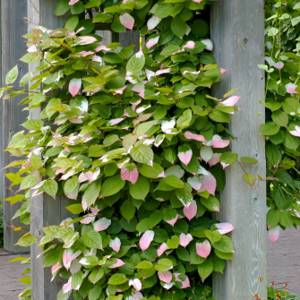
Actinidia kolomikta on a pergola
Actinidia is also considered an ornamental foliage crop, although strictly speaking it is a fruit vine. Actinidia kolomikta feels great in shade and can even be used to decorate a gazebo in the shade of a large tree.
Not limited to ten meters in height, actinidia attracts with large matte bright green leaves with an unusual shade and purple edge and unevenly appearing purple, pink and white spots. The color of the leaves changes during flowering, when the classic green is literally colored with acrylic white and then pink spots. Fragrant, not too flashy flowers are replaced by tasty and attractive berries.
Choosing climbing plants for a garden arch
The completeness of the structure is given by its natural design, which implies harmonious placement on the site, taking into account buildings, fences and the location of trees, flower beds and shrubs. If secondary buildings do not look very aesthetically pleasing, a properly installed and decorated arch will completely attract the attention of others. But you need to think through everything: from the size and type of material to the style and choice of vegetation around and on the structure.
Experienced gardeners and designers believe that the best climbing plants for a garden arch are:
- Maiden's grapes. Green foliage completely envelops the surface of the arch in the summer, and in the fall it turns into a red-crimson extravaganza. The plant is unpretentious and grows quickly.
- Clematis. The riot of colors of different varieties of this flower will make the arch elegant and festive.
- Climbing roses. They also have many varieties, differing in the color and size of the flowers, as well as the height of the stem. They bloom once a year, but very brightly, and the foliage has a rich green color.
Other plants, such as honeysuckle, ivy, actinidia, wisteria, larch and cedar, will also look non-trivial.
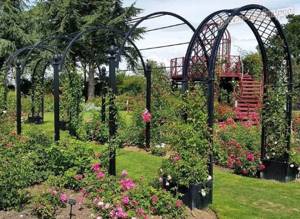
For purely decorative arches, choose proximity to straight-trunked trees. For example, with birch, fir. They are most often used for wooden arches with rustic styling.
Plants should be constantly pruned, giving a certain shape, then they will look like a single composition. And the stems of climbing varieties are first pulled into the arch and, if necessary, secured with plaits.
If you plan to install an arch in a recreation area, then think through the relationship between construction material and style in order to recreate a solid ensemble.
Temporary helpers - annual climbing vines for quick design
Perennial vines are the main, but not the only design option for gazebos and pergolas. If you have not yet decided on the concept, you want to see in practice how a structure with a plant will look, you still have construction work not completed, or you simply don’t have time for full-fledged landscaping, then you can use the fastest decoration method - annual vines. Even if they are only for one season, they will put on an unforgettable show. You can use annual vines for another purpose:
- enhance the beauty of the main vine;
- decorate the gazebo before the main plants become decorative and grow;
- add color or novelty to the design;
- extend the flowering period, etc.
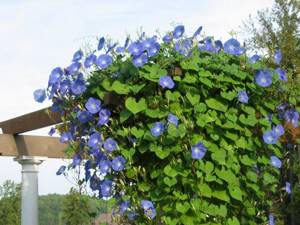
The best annual climbing vines for landscaping pergolas and gazebos include:
- sweet pea;
- quamoclite lobed;
- kobeyu;
- morning glory;
- decorative beans;
- decorative pumpkins, etc.
The most popular climbing species
Clematis on the balcony
You can plant a beautiful perennial clematis.
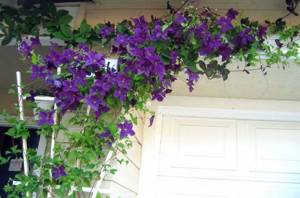
This flower has beautiful bright flowers and a woody stem. Many varieties are characterized by a scent reminiscent of jasmine. Does not like drafts and bright afternoon sun. It is ideal if the balcony with climate control faces the south, south-east or south-west. For beautiful weaving, it is useful to make designs in the form of a fan, pyramid or arch.
Important: where the flower touches, the support must have a diameter not exceeding 10 mm.
The lifespan of one flower ranges from 15 to 20 days.
For planting, you should choose a container made of wood or plastic and renew the soil in it every three years. Since the root system is powerful, there should be a lot of soil, the drainage height should be at least 8 cm. The plant is moisture-loving, the soil in the pot should always be moist.
With proper care, clematis can turn walls into a real flowering gazebo.
Chinese lemongrass
Suitable perennial plants for the balcony include Chinese lemongrass. It is a tree-like flower with a flowering period of one week. The fruits are tasty and edible. For successful growth, lemongrass needs to create conditions close to natural: plenty of light, protection from the wind, sufficient watering and pruning.
Fertilizing and settled water for irrigation are useful. Since this is a moisture-loving species, the soil must be constantly moist. However, he will not put up with stagnant water. Otherwise, the roots begin to rot. In summer, it is useful to spray the branches with slightly warm water. When the plant reaches 3 years of age, it is advisable to add liquid organic fertilizers to the soil.
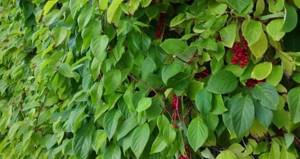
In order for foliage to form in a directional manner, the trunk and side shoots must be trimmed. Only young strong branches are left.
The list of annual options for braiding a balcony is long. Each of them has its own characteristics. However, there are common features that distinguish this group. They:
- do not require complex care;
- grow without stable supports;
- do not require specific conditions, incl. special soils;
- love light and moisture;
- quickly increase in size.
From them you can create original compositions, starting from the first days of June and ending in late autumn.
Decorative beans (“Sissie”)
An example of a commonly used annual plant is the ornamental bean. People call her a sissy. The miniature red flowers look like moths. The lash branches can reach a length of 3-4 m. They intensively entwine the support, completely covering it with their wide leaves.
Sweet peas on the balcony
Sweet pea is an equally exquisite flower with a delicate scent. The most capricious plant growers do not remain indifferent to it. Polka dots are beautiful on their own and elegant in compositions. Pleasant to the eye from April until the onset of cold days. Peas are not picky about soil. Therefore, universal soil is suitable for planting. By its nature, the plant is strong and survives well in different conditions. It prefers to grow in bright sunny places, but during the scorching sun it is better to organize shade for it.
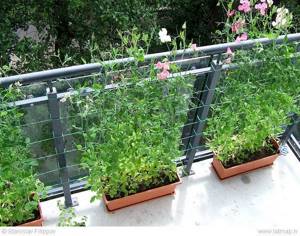
It’s great if the loggia is oriented north. Since peas are heat-loving, they cannot withstand a sharp drop in air temperature. In such conditions, he will immediately drop the flowers. Likes infrequent but regular watering. Reacts well to spraying leaves with plain water. The specialist is advised to feed the seedlings with nitrogenous fertilizers. Before flowering, mineral compounds can be added to the soil.
